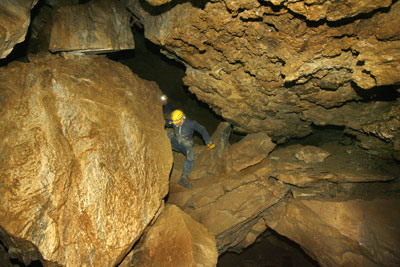|
Into the abyss at the Oregon Caves
 |
Zach Urness/Daily Courier
Heading into the dark passageways at the Oregon Caves' off-trail tour. |
The off-trail tour at the Oregon Caves National Monument takes visitors into the depths during an experience that’s challenging, exhilarating and muddy. For detailed information, see the information box below. For a photo gallery, click here.o o o oBy Zach Urness of the Daily CourierIt begins when you pop on your headlamp, illuminating the perpetual darkness of the Oregon Caves National Monument.But it’s not until you crawl head-first into passageways so tight they appear little more than wormholes into the abyss, that you start to understand what off-trail caving is all about.One moment you’re climbing a steep, muddy boulder while the next you’re slithering between cracks of marble, dragging yourself forward on knees and elbows.The good news is you’re not alone. Even in the darkest passageways, you can see the faint glow from the person ahead, providing a torchlight beacon through the small intestines of Southern Oregon’s national monument.This past weekend I went off-trail at the Oregon Caves, during the “Introduction to Caving” tour offered each Friday, Saturday and Sunday from July 1 to Sept. 4. The tour costs $30 and includes a helmet, headlamp, gloves and kneepads.And even though you’re following a trained guide through the network of tunnels and rooms, the experience feels largely independent. It’s physically challenging, exhilarating and muddy — and certainly not for those with claustrophobia.That much becomes obvious quickly. After stepping off the regular tour route’s path, our group ducked into a narrow tunnel, used a fixed rope to descend a steep drop and crawled into the first wormhole passage.Any fear of tight spaces would be realized here. There’s about one foot between ceiling and floor — almost like the gap in an iron vise — and you’re basically inching forward on elbows and knees. “The idea is to provide a wild experience, through a section of the cave in its natural condition,” said Elizabeth Hale, who guided our tour and helped design the off-trail tour. “One of the things I really enjoy about caving is there’s something new around every corner. Each room has a secret waiting to be discovered.”The first spot we discovered was the “snake room,” a long narrow hideaway with jagged, multi-colored arches. The room is named for a snake-like pendant that sticks out horizontally and not, thankfully, for any scaly residents.Which brings me to a sort of side note. Part of any trip to the Oregon Caves should include learning about the 155 different animals that have called the caves home at some point, including the eight species found nowhere else on earth.However, I would recommend gaining this information AFTER an off-trail tour, rather than before.The off-trail tour I took actually was part of a speleology class offered by the Siskiyou Field Institute. And part of the class involved watching a slideshow of the caves’ unique critters.There were pictures of a Camel Cricket the size of a human palm, a pseudo-scorpion with pinchers and — wait for it — a cluster of 2,000 daddy longlegs spiders all hanging out together, as though waiting for a party to begin.“We see a lot of spiders in the summer,” Hale remarked.Ummm ...We’re heading into a pitch-black tomb populated by a metropolis of spiders?In fairness, nobody in our group had any problems, and Hale said bugs never have been an issue on the off-trail tour.The cave creatures we did run into ended up being pretty cool. In the deeper region of the caves, we found a springtail, and higher up there was a cave-adapted harvestman. Both were tiny, white bugs — called troglobites — showcasing the adaptations evolved for life in such a bizarre environment.Looking at such strange creatures reminds you that a cave is unlike any place on earth. It’s something you understand in that primal section of your brain, but it takes heading down into the depths, off-trail, to fully appreciate it.After a few more belly-crawls through tight spaces, we arrived at the South Room. It’s the second largest chamber and among the deepest at 300 feet below the earth.Once we became comfortable, everyone in the group turned off their headlamps and were silent for a few minutes.Utter darkness came showering down, so deep and thick it seemed almost tangible, like a substance you could touch.The strangest part of sitting in that level of darkness is you can’t see your own body — not even a hand inches from your eyes.It’s just your mind, hovering somewhere in the blackness, clinging to the sound of water dripping on rock. The feeling was both deeply peaceful and disorienting, something I’d never quite experienced.Eventually we flipped on our headlamps again, regaining that power of sight that you don’t fully appreciate until it’s gone, and headed back toward the surface.Being encased by stone hundreds of feet thick is a strange experience, and probably a good way to lose your mind. But it’s also a way to reconnect with a part of the earth that still feels primal and raw, and that can only be found off-trail.o o o oOregon Caves National MonumentOff-Trail Caving ToursCost: $30Season: July 1 to Sept. 4When: Friday (10 a.m. and 2 p.m.), Saturday (10 a.m. and 2 p.m.), Sunday (10 a.m.)For more information: 541-592-3400; nps.gov/orcaIn a nutshell: Explore tight passages of the Oregon Caves during an adventurous tour of the areas located off the main trail.Bonus: The cave is 44 degrees, providing a cool escape from August temperatures.
| |
|





